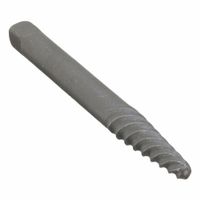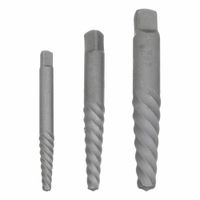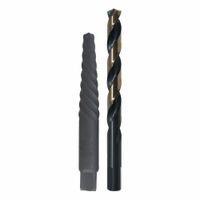Call +(254) 703 030 000 / 751 483 999 / 721 704 777
- Home
- Tools
- Hand Tools
- Bolt Screw Extractor Tools
.....Read More
Frequently Asked Questions
What is a bolt and screw extractor?
A bolt and screw extractor is a specialized tool used to remove broken, damaged, or stripped screws and bolts that cannot be easily removed with standard tools. These extractors are essential in situations where the head of a screw or bolt is damaged, making it impossible to use a screwdriver or wrench.
The extractor typically has a reverse-threaded design, which allows it to grip the inside of the damaged fastener. To use it, a pilot hole is first drilled into the center of the broken screw or bolt. The extractor is then inserted into this hole and turned counterclockwise. As it turns, the reverse threads dig into the metal, providing a strong grip that allows the user to back out the fastener.
There are different types of extractors, including spiral flute extractors, which are tapered and have a spiral design, and straight flute extractors, which have straight grooves and are used for softer materials. Some extractors come in sets with various sizes to accommodate different fastener diameters.
Using a bolt and screw extractor requires precision and care to avoid further damaging the fastener or the surrounding material. It is important to select the correct size of extractor and to drill the pilot hole accurately. Additionally, applying penetrating oil can help loosen the fastener, making extraction easier.
Overall, bolt and screw extractors are invaluable tools in mechanical, automotive, and construction work, providing a solution for removing stubborn fasteners without damaging the workpiece.
How do you use a screw extractor?
To use a screw extractor, first gather the necessary tools: a drill, a drill bit slightly smaller than the screw extractor, a hammer, and the screw extractor set. Begin by ensuring the screw head is clean and accessible. If the screw is stripped, use a center punch to create a small indentation in the center of the screw head to prevent the drill bit from slipping.
Select a drill bit that matches the size of the screw extractor. Attach the drill bit to the drill and carefully drill a hole into the center of the screw. The hole should be deep enough to accommodate the screw extractor but not so deep that it damages the surrounding material.
Once the hole is drilled, choose the appropriate size screw extractor from the set. Insert the screw extractor into the drilled hole. If the extractor has a square head, use an adjustable wrench or a T-handle to turn it. If it has a spiral flute design, tap it gently into the hole with a hammer to ensure a snug fit.
Turn the screw extractor counterclockwise. As you turn, the extractor will grip the inside of the drilled hole and begin to remove the screw. Apply steady, even pressure to avoid breaking the extractor. If the screw is particularly stubborn, apply a penetrating oil to help loosen it.
Continue turning until the screw is fully removed. If the screw extractor slips or fails to grip, reassess the hole size and depth, and try again with a different extractor size if necessary. Once the screw is removed, clean the area and replace the screw if needed.
What size screw extractor do I need?
To determine the appropriate size of a screw extractor, you need to consider the size of the screw or bolt you are trying to remove. Screw extractors are typically matched to the diameter of the screw or bolt. Here’s a step-by-step guide to help you choose the right size:
1. **Identify the Screw Size**: Measure the diameter of the screw or bolt. This can be done using a caliper or a screw gauge. If the screw head is stripped, measure the shank or the part of the screw that is still visible.
2. **Consult the Extractor Set**: Most screw extractor sets come with a chart or guide that matches screw sizes to the appropriate extractor size. Refer to this chart to find the corresponding extractor for your screw diameter.
3. **Choose the Correct Extractor**: Select the extractor that matches the size of your screw. Extractors are usually labeled with a range of screw sizes they can handle. Ensure the extractor you choose falls within this range.
4. **Consider the Type of Extractor**: There are different types of extractors, such as spiral flute, straight flute, and multi-spline. Spiral flute extractors are common for smaller screws, while multi-spline extractors are used for larger bolts. Choose the type that best suits your needs.
5. **Test Fit**: Before proceeding, test the extractor in the screw to ensure a snug fit. It should grip the screw securely without slipping.
By following these steps, you can select the correct size screw extractor to effectively remove the damaged screw or bolt.
Can a screw extractor remove any type of screw or bolt?
A screw extractor is a tool designed to remove broken or damaged screws and bolts. While it is a versatile tool, it cannot remove every type of screw or bolt in every situation. The effectiveness of a screw extractor depends on several factors:
1. **Type of Screw or Bolt**: Screw extractors are generally effective on standard screws and bolts, including those with stripped heads. However, they may struggle with specialized or tamper-proof screws, which require specific tools for removal.
2. **Material and Condition**: The material of the screw or bolt can affect the extractor's success. Harder materials, such as stainless steel, may be more challenging to extract. Additionally, if the screw or bolt is severely corroded or rusted, it may be more difficult to remove.
3. **Size and Fit**: The size of the screw or bolt must match the size range of the screw extractor. Using an incorrectly sized extractor can lead to further damage or failure to remove the screw.
4. **Access and Space**: The location of the screw or bolt can impact the ability to use a screw extractor. If the screw is in a tight or awkward space, it may be difficult to apply the necessary force or angle for extraction.
5. **Condition of the Extractor**: The condition and quality of the screw extractor itself are crucial. A worn or low-quality extractor may not grip the screw effectively, leading to slippage or breakage.
In summary, while a screw extractor is a valuable tool for removing many types of screws and bolts, its success is not guaranteed in every situation. Factors such as the type, material, size, and condition of the screw or bolt, as well as the quality of the extractor, all play a role in determining its effectiveness.
What is the best screw extractor set?
The best screw extractor set is often considered to be the Irwin Tools Hanson Spiral Extractor and Drill Bit Set. This set is highly regarded for its durability, versatility, and effectiveness in removing stripped or broken screws and bolts. It includes a range of spiral extractors and matching drill bits, which are made from high-carbon steel, ensuring long-lasting performance and resistance to wear. The spiral design provides a strong grip on the screw, making it easier to extract even the most stubborn fasteners. Additionally, the set comes in a convenient case for easy organization and portability.
How do you remove a broken bolt without a screw extractor?
1. **Safety First**: Wear safety goggles and gloves to protect yourself from metal shards.
2. **Assess the Situation**: Determine how much of the bolt is exposed. If a portion is sticking out, you may have more options.
3. **Lubricate**: Apply penetrating oil (like WD-40) around the bolt. Let it sit for at least 15 minutes to loosen any rust or debris.
4. **Use Pliers or Vice Grips**: If the bolt is protruding, grip it tightly with locking pliers or vice grips and try to turn it counterclockwise.
5. **Drill a Hole**: If the bolt is flush or recessed, use a center punch to mark the center of the bolt. Drill a small pilot hole into the center using a drill bit slightly smaller than the bolt diameter.
6. **Reverse Drill Bit**: Use a left-handed drill bit, which can sometimes grip and unscrew the bolt as it drills. Drill slowly to avoid breaking the bit.
7. **Tap and Die Set**: If the bolt is still stuck, use a tap and die set to re-thread the hole. This can help in removing any remaining fragments.
8. **Heat Application**: Carefully apply heat to the surrounding area with a propane torch. The expansion and contraction can help break the bond. Be cautious of flammable materials.
9. **Hammer and Chisel**: For stubborn bolts, use a hammer and chisel to create a notch on the bolt's edge. Tap the chisel counterclockwise to turn the bolt.
10. **Weld a Nut**: If accessible, weld a nut onto the broken bolt. Once cooled, use a wrench to turn the nut and remove the bolt.
11. **Clean the Threads**: Once removed, clean the threads with a tap to ensure they are ready for a new bolt.
Are there different types of screw extractors?
Yes, there are different types of screw extractors, each designed to handle specific situations and types of damaged screws or bolts. The main types include:
1. **Spiral Flute Extractors**: These are the most common type and are designed with a tapered, spiral-shaped flute. They work by being twisted into a pre-drilled hole in the damaged screw, allowing the spiral flutes to grip the screw tightly as you turn the extractor counterclockwise. This type is ideal for softer materials and screws that are not too tightly fastened.
2. **Straight Flute Extractors**: These have straight, non-tapered flutes and are used for removing screws or bolts that are softer or have been stripped. They are often used in conjunction with a tap wrench and are suitable for situations where the screw is not deeply embedded.
3. **Double-Ended Extractors**: These have two ends, one for drilling a hole into the screw and the other for extracting it. They are convenient for quick jobs as they combine the drilling and extracting functions into one tool.
4. **Multi-Spline Extractors**: These have multiple splines that provide a strong grip on the inside of the drilled hole. They are used for high-torque applications and are effective on harder materials.
5. **Bolt Extractors**: Specifically designed for bolts, these extractors have a socket-like design with reverse threads that grip the bolt head. They are used with a ratchet or wrench and are effective for removing rounded or rusted bolts.
6. **Square Extractors**: These have a square-shaped head and are used with a wrench or pliers. They are less common but can be useful for certain types of screws or bolts.
Each type of screw extractor is suited for different materials and levels of damage, so selecting the right one is crucial for effective screw removal.


